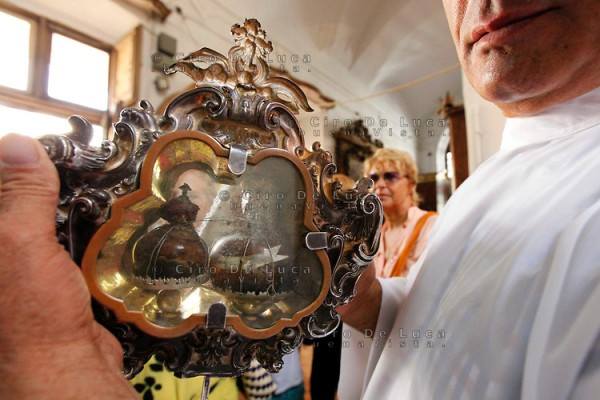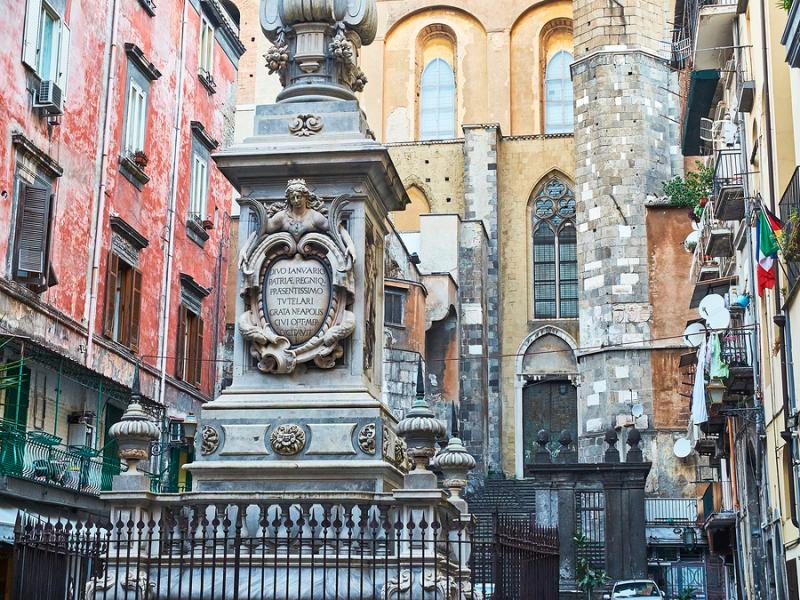With the holiday season over in all its glory, Naples still revels in its celestial splendor. There are shrines, frescos, statues and reliquaries that stretch across the town to honor the holy family and the birth of baby Jesus. And while Neapolitans love their Madonna and child, the town actually enjoys the patronage and protection of over fifty saints, each with special powers and supernatural miracles vying for ecclesiastic intercession. These saints, original power rangers of paleo Christian Italy, can alternately intercede to cure blindness, epilepsy, poorly cooked pizza and baldness. Most locals have their favorites depending on the day of the week, the personal predicament, profession or alignment of the stars. The most often appealed to saints enjoy near universal adoration and when you’re in a pinch, they certainly stand ready to assist. Also they often get you out of work for a day and have special treats named in their honor.
Saint Gennaro
Saint Gennaro is the saintly rock star of the Neapolitan firmament. Born somewhere between Naples and Benevento in 272 AD, he was one of Naples original Christian martyrs. As the Bishop of Naples, San Gennaro converted many old pagans to Christianity eventually running afoul of Roman authorities. They were having none of it so they decided to feed him to a pack of wild bears at the Flavian Amphitheater in Pozzuoli, just outside of Naples. At the last minute, fearing mobs of angry local Christians, the Romans benevolently decided to behead the Bishop of Naples in the solfatara volcanic crater of Pozzuoli. Nobody really knows what happened to San Gennaro’s body immediately after the beheading but legend holds that local faithful collected vials of his blood at the time of his death.
Over 1,000 years after Gennaro’s death, these vials of blood popped up in Naples in 1389 and to this day, Saint Gennaro’s blood, which is stored in a heavy baroque vial in the Duomo of Naples, spontaneously liquefies three times a year. The liquefaction happens on Gennaro’s saint day of September 19 and again on December 16 and finally on the first Sunday of May. The liquefaction is no laughing matter for Neapolitans. The descendants of San Gennaro along with thousands of worshipers gather at the Duomo to await news of the liquefaction. A bishop holds the vial and gazes at it. Adherents pray and pray, begging San Gennaro to intercede and invoke the liquefaction. When the blood liquefies, a bishop makes a formal announcement, which is broadcast on local television, radio and now Facebook and Instagram. To celebrate, Neapolitans launch fireworks. More disturbing is when San Gennaro’s blood fails to liquefy. In past years, the blood’s failure to liquefy has coincided with earthquakes, volcanic eruptions, cholera outbreaks, world war and more seriously several lost soccer matches. Interestingly, the Vatican does not officially recognize the miracle of San Gennaro’s blood. Just try telling a Neapolitan that.
Saint Patrizia of Constantinople
Not to be outdone, Saint Patrizia, likely the second most venerated saint in Naples also has blood that miraculously liquefies at specific intervals. But her’s does not just liquefy three peasley times a year. Her blood liquefies on August 25th, her saint day and also every Tuesday morning at San Greogio Armeno Church in the historic center of Naples. Patricia was an OG lady boss. Born into a noble family with links to Roman emperors, many believe she was a descendent of Constantine the Great. Like many other strong independent women of her day, she became a nun to escape an arranged marriage. After joining a convent in Rome and renouncing her earthly possessions, she boarded a ship to make a pilgrimage to Jerusalem. Her ship got caught in a terrible storm in the Bay of Naples and like the Greek siren Partenope before her, Saint Patrizia’s body washed ashore on the Neapolitan island of Megaride, home to Castel del’Ovo. Years later, her relics, preserved in wax showed up at San Gregorio Armeno Church.

One day, a knight on his way to Jerusalem prayed at the tomb of the Saint Patricia. After praying incessantly, he opened a reliquary urn and drew out Saint Patricia’s tooth. The tooth spouted blood that has been liquefying once a week every since. Saint Patrizia, who died a virgin, is venerated as the patron saint of single ladies. Women seeking life mates, flock to Saint Patrizia’s relics to pray for love and marriage. If you are seeking such celestial dating counsel, you can visit Saint Patrizia every Tuesday morning at 9:30AM, where the sisters of Saint Patrizia will allow you to kiss the vial containing her blood.
Saint Anthony the Abbot
Not to be confused with Saint Anthony of Padova, Saint Anthony the Abbot was the elder and original Saint Anthony. He is the patron saint of pizza makers, fire fighters and pigs. Saint Anthony renounced his possessions to become a hermit and roam the Egyptian Dessert in the 3rd century AD. While roaming in the desert as a shepherd, Saint Anthony frequently encountered the devil who tempted him to renounce his ascetic life. On one particularly pernicious occasion, the devil opened up the fires to hell and Saint Anthony’s favorite pig jumped into the hell pit. The saint, refusing to fear the devil, braved the hell fires and rescued his piglet.

Today Neapolitans venerate Saint Anthony the Abbot’s bravery on January 17th when they light massive bonfires across the city and throw household refuse, old furniture, toys and clothing into the growing flames. This ritual purification symbolizes the Saints bold passage through the flames of hell and his ultimate triumph over the devil. Perhaps most popularly, Saint Anthony is the patron saint of pizzaioli, pizza makers. Given their daily toils stoking the wood burning pizza ovens across town, it would makes sense Neapolitan pizza makers have a certain kinship with the old flame tosser Saint Anthony. When you venture into a pizzeria in Naples you will almost certainly notice a small shrine above the pizza oven honoring Saint Anthony the Abbot and his pig.













